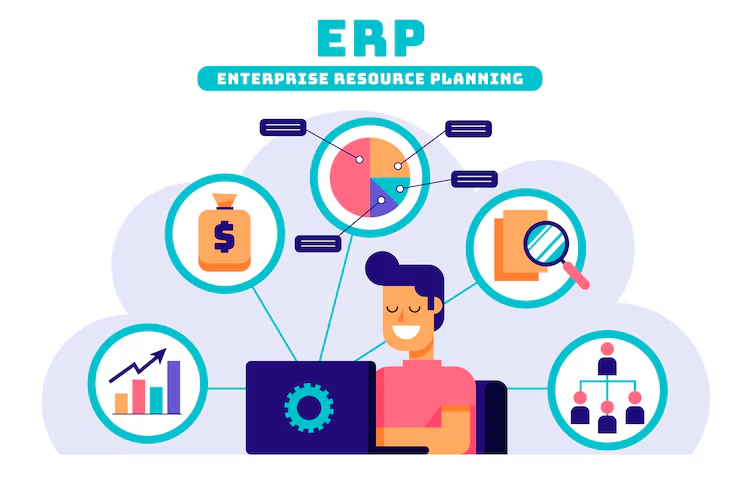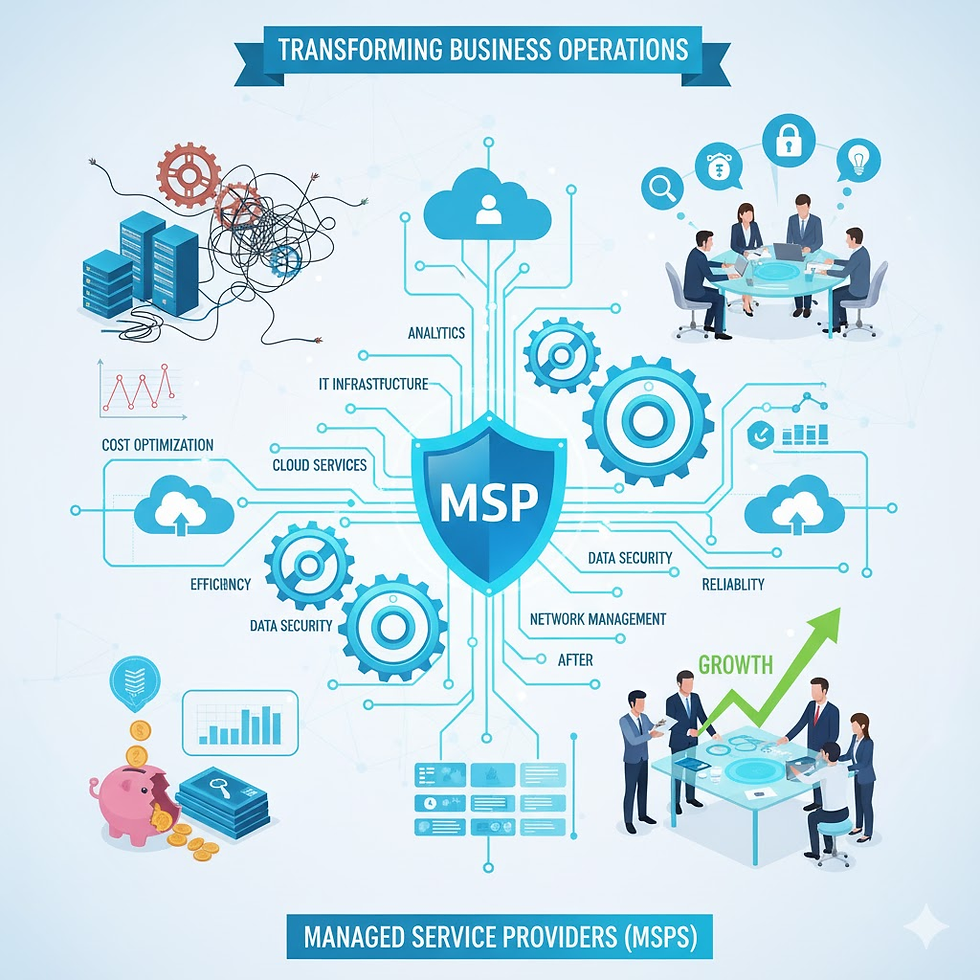What is Enterprise Software and Why Your Company Needs It
- Staff Desk
- Jun 5
- 6 min read
Updated: Jun 27

In today's fast-paced business world, companies of all sizes are turning to enterprise solutions to streamline operations, boost productivity, and drive growth. Whether you're a small startup or a large corporation, enterprise solutions could be the game-changer your business needs.
Defining Enterprise Software and Systems
What is enterprise software? Simply put, it refers to applications and systems designed to support the core operations of large organizations. These tools are built to manage business processes such as finance, supply chain, customer relationships, and human resources. To define enterprise software, think of platforms like ERP, CRM, and HRM that help streamline and automate company-wide functions. Similarly, what is an enterprise software or what is an enterprise system points to the same suite of tools designed to ensure operational efficiency, integration, and scalability across departments.
Understanding Enterprise Software
Enterprise software, also known as enterprise application software (EAS), refers to the complex, scalable platforms that support business processes in large organizations. These tools typically handle critical functions such as accounting, human resources, and customer relationship management.
What Are Enterprise Solutions?
Many decision-makers ask, what is enterprise solutions and how do they differ from regular software? To define enterprise solutions, they are comprehensive software packages tailored to meet complex business needs. These solutions often involve modules for inventory control, financial management, project tracking, and analytics. Enterprise software solutions are customizable, scalable, and can integrate with other enterprise IT systems to support a company’s digital transformation journey.
The Evolution of Enterprise Software
Enterprise software has evolved significantly over the past few decades. Early implementations were often on-premise, monolithic systems that required substantial hardware investments and long deployment times. Today, modern enterprise solutions leverage cloud computing, microservices, and mobile accessibility, delivering powerful tools that were once only available to large corporations.
Cloud vs. On-premise Solutions
When it comes to enterprise software, businesses have the option to choose between cloud-based solutions or on-premise deployments. Cloud solutions offer flexibility, scalability, and reduced upfront costs, while on-premise deployments provide greater control over data and can be crucial for industries with strict regulatory requirements.
The Role of AI and Machine Learning
Artificial intelligence (AI) and machine learning are increasingly embedded into enterprise software, enabling advanced analytics, automation, and predictive insights. These technologies help organizations make data-driven decisions, reduce manual tasks, and improve operational efficiency.
Key Features of Enterprise Software
Enterprise software is characterized by its ability to integrate complex business processes and functions. Here are some key features:
Scalability: Enterprise software is designed to handle the needs of growing businesses, allowing seamless operations without the need for constant upgrades.
Integration: One of the main benefits is the ability to integrate with other systems and databases, reducing data silos and facilitating smooth workflow across the organization.
Customization: Most enterprise solutions offer customization options to tailor workflows, interfaces, and reports to specific business needs and objectives, enhancing productivity and user satisfaction.
Security: Given the scale and sensitivity of the data handled by enterprises, robust security measures such as encryption, access controls, and audit trails ensure that sensitive business information remains protected at all times.
Types of Enterprise Software

There are several types of enterprise software solutions, each addressing different business functions but often working together to streamline business processes:
Enterprise Resource Planning (ERP)
ERP systems are a type of enterprise software that integrates core business functions—such as finance, operations, and supply chain management—into a unified platform to improve efficiency and collaboration by improving the flow of information across the organization.
Comprehensive Resource Management
ERP systems provide a centralized platform for managing resources such as inventory, human resources, and finances. This centralized approach enables businesses to make informed decisions about allocation and investment.
Streamlining Financial Operations
Financial management is a crucial component of ERP systems. These tools offer features like automated invoicing, real-time financial reporting, and budget tracking to improve cash flow, and ensure compliance with financial regulations.
Enhancing Supply Chain Efficiency
ERP systems enhance supply chain efficiency by providing end-to-end visibility into procurement, production, and distribution processes. This visibility reduces bottlenecks, reduces lead times and improving customer satisfaction.
Customer Relationship Management (CRM)
CRM software focuses on managing a company's interactions with current and potential customers. These platforms help businesses track customer interactions, manage leads, and automate marketing tasks.
Building Stronger Customer Relationships
CRM systems enable businesses to build stronger relationships with customers by providing a 360-degree view of customer data. This insight allows companies to deliver personalized experiences and targeted marketing campaigns that resonate with their audience.
Automating Sales and Marketing
CRM tools offer automation features for sales and marketing, such as lead scoring, email campaigns, and sales pipeline management. These automated processes help sales teams focus on closing deals while marketing teams optimize campaign performance.
Human Capital Management (HCM)
HCM software helps organizations manage employee-related processes, from recruiting and onboarding to payroll and performance management. These platforms ensure that businesses can effectively attract, retain, and develop top talent.
Optimizing Workforce Performance
HCM systems provide performance management features like goal setting, feedback, and evaluation tools to help employees develop their skills and achieve their professional objectives.
Streamlining Talent Acquisition
Recruitment modules within HCM software automate job postings, applicant tracking, and interview scheduling, accelerating the hiring process and improving candidate experience.
Improving Employee Engagement
HCM solutions often include tools for employee surveys, recognition programs, and collaboration platforms, fostering a positive work environment and increasing employee satisfaction.
Business Intelligence (BI)
BI software enables organizations to analyze data from various sources, generate insights, and make informed decisions. These tools often include dashboards, reporting tools, and data visualization capabilities.
Data-Driven Decision Making
BI platforms consolidate data from multiple systems, providing a single source of truth for decision-makers. This consolidation allows executives to base strategies on accurate, real-time information.
Real-Time Analytics
With real-time analytics, businesses can monitor key performance indicators (KPIs) and operational metrics, identifying trends and addressing issues before they escalate.
Predictive Modeling and Forecasting
Advanced BI tools leverage machine learning algorithms to create predictive models and forecasts. These capabilities help organizations anticipate market trends, customer behavior, and operational challenges.
Why Your Business Needs Enterprise Software
Now that we understand the enterprise software definition, it's clear why it's essential for growing companies. Enterprise tools enhance collaboration, improve data accuracy, and offer real-time insights into key operations. Whether you're expanding, managing multiple departments, or aiming for digital efficiency, enterprise software provides the structure and automation your business needs to scale effectively. In short, adopting enterprise systems isn't just about keeping up—it's about staying ahead.
Selecting the Right Enterprise Software

Choosing the ideal enterprise software solution requires a structured approach. Here are key steps to guide your selection process:
Define Your Business Requirements
Before evaluating any software options, clearly outline your organization's needs, goals, and operational challenges. This foundational understanding will serve as the basis for comparison and ensure you select a solution that aligns with your objectives.
Research Available Solutions
Once your requirements are defined, research the market to identify potential software vendors. Consider factors such as industry reputation, feature sets, and scalability to narrow down your options.
Gathering Requirements from Stakeholders
Engage stakeholders across departments—such as finance, operations, and IT—to gather comprehensive requirements. Their insights will help you understand the specific functionalities needed to support various business processes.
Prioritizing Features Based on Value
Create a prioritization matrix to rank software features based on their potential value to your organization. This exercise helps ensure that essential functionalities are addressed first and prevents feature bloat.
Evaluating Vendor Reputation
Assess vendor credibility by reviewing case studies, customer testimonials, and industry awards. A vendor with a strong track record is more likely to offer reliable support and continuous product improvements.
Assess Product Roadmaps
Evaluate each vendor's product roadmap to understand their long-term vision and commitment to innovation. Ensure their future development plans align with your organization’s strategic goals.
Consider Implementation and Support Services
Investigate the vendor’s implementation process, training programs, and ongoing support services. A smooth rollout and strong post-implementation support are critical to achieving project success.
Testing and Proof of Concept
Before making a final decision, conduct a proof of concept (POC) or pilot test to evaluate the software's performance, usability, and compatibility with your existing systems.
Creating a Testing Plan
Develop a detailed testing plan that includes test scenarios, user roles, and success criteria. This plan ensures that all critical functionalities are thoroughly evaluated during the POC phase.
Gather feedback from potential users within your organization to validate usability and effectiveness, helping you make an informed decision.
Encourage end-users to provide feedback on the software’s interface, workflow, and features. Their firsthand experiences will help identify any usability issues and ensure a higher adoption rate post-implementation.
Assessing Integration Capabilities
During the testing phase, assess the software's integration capabilities with your existing applications, databases, and third-party systems. Ensure that the new software enhances rather than disrupts your business operations.
Consider Long-term Scalability
Choose a solution that can grow with your business. Your enterprise software should handle increased data loads and support additional users as your company expands.
Planning for Future Growth
Consider your organization's long-term growth plans and ensure the software can adapt to changes in market conditions, organizational structure, and technology trends.
Evaluating Flexibility and Customization
Evaluate the flexibility and customization options offered by each software solution. The ability to tailor the software to fit your evolving processes and objectives can be a significant differentiator.
Assessing Total Cost of Ownership
Consider the total cost of ownership, including initial investment, implementation fees, licensing, maintenance, and support costs. A comprehensive view of all expenses will help you budget effectively for long-term success.
Conclusion
Enterprise software is a powerful tool that can transform the way organizations operate. By understanding your company's specific needs and long-term goals, you can find the right fit.
Investing in enterprise software is not just about keeping up with technology—it’s about empowering your business to achieve its full potential, driving innovation and achieving its strategic objectives.






Comments